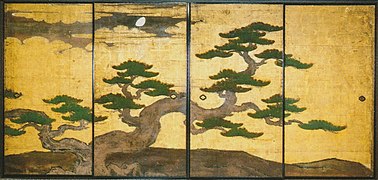Keishun-in
The Keishun-in ( Japanese 桂春院 ) is one of the 48 sub-temple of Zen - Temple Myoshin-ji in Japan's capital Kyoto . He is known for his remarkable garden, which is open to the public.
history
The temple was founded in 1598 by Tsuda Hidenori ( 津 田 秀 則 ;? –1625). This was the second son of Oda Nobutada ( 織田 信 忠 ; 1557–1582) and thus the grandson of the powerful feudal lord Oda Nobunaga . The temple was originally called Kenshō-in ( 見 性 院 ), but was built in 1632 by its patron Ishikawa Sadamasa ( 石河 貞 政 ; 1575-1657), who came from a wealthy family in the province of Mino , on the occasion of the 50th anniversary of the death of his father Ishikawa Mitsumasa ( 石河 光 政 ), renamed Keishun-in.
building
You enter the temple from the west through a small temple gate (1 on the map). The abbey ( 方丈 Hōjō ; 2) was built in 1631. This building has a half-hip roof and is covered with tiles ( 棧 瓦 葺 Sagawara-buki ). In the center is the prayer room with the main cult figure, a Yakushi Buddha , and another room. All sliding doors ( 襖 Fusuma ) were painted with landscapes by Kanō Sansetsu , Sansetsu's master student. In the middle, on the sliding doors, you can see a landscape with bare trees and ravens, a dock for boats and monks. In the room to the east you can see a landscape with landing wild geese, in the room to the west old pine trees and a entwined waterfall. The composition on sliding doors "Three-day moon and pines on a gold background" ( 金碧松 三 日月 Kinpekimatsu mikazuki ) was originally a mural behind the altar.
Garden area
- The small Shōjō garden ( 清浄 の 庭 ; A) - garden of purity - is laid out as a dry garden ( Kare-san-sui ) in the inner courtyard north of the abbey. There is a spring there and a dry waterfall in the northwest corner, made of large and unusual stones from Wakayama Prefecture .
- The Shii Garden ( 思惟 の 庭 ; C) - Garden of Thoughts - is located east of the abortion residence. There are 16 Arhat statues on two artificial elevations. The basic stone in the middle is intended to be a Zen meditation stone. Taken together, the garden gives the impression of a fairytale land.
- The Shinnyo Garden ( 真如 の 庭 ; D) - Garden of Absolute Truth - south of the abbey is uniformly covered with pruned rhododentron shrubs on the upper level and with maple on the level below. The ground is covered with thick moss. There are 15 stones in a 7-5-3 arrangement. They indicate the full moon, which according to the old lunar calendar can be seen on the 15th day of the month.
- The wabi garden ( 侘 の 庭 ; E) - garden of simplicity as beauty and imperfection - is a roji, a tea garden. A flagstone path leads down through the garden. The Baiken Gate ( 梅 軒 門 ) and a garden gate ( 猿 戸 Saru-do ) separate the outer and inner areas. The garden then descends even further. At the bottom, seven stones "sit" like Buddhas, there is a water source and the blue dragon pond ( 緑 龍池 ). The garden was mentioned in a description by Kyōto in 1799 and received the award "Beautiful History Trail " ( 史蹟 名勝Shiseki meishō ) in 1931 .
Tea room
- The tea room Kihaku-an ( 既 白 庵 茶室 Kihakuan chashitsu ; 3) "Almost white hermitage" is hidden behind the northeast corner of the Shoin ( 書院 ), i.e. the abbot's private rooms. The tea room is said to have come here from Nagahama Castle along with the Shoin in 1631 . It is not open to the public.
photos
Remarks
- ↑ Roji ( 路地 ) actually only means a narrow path, the path to the tea house.
literature
- Folders of the temple to the garden, Japanese, English
- Kyoto-fu rekishi isan kenkyukai (Ed.): Keishunin . In: Kyoto-fu no rekishi sampo (jo). Yamakawa Shuppan, 2011. ISBN 978-4-634-24626-3 . P. 251.
Web links
Coordinates: 35 ° 1 ′ 29.5 ″ N , 135 ° 43 ′ 20.8 ″ E





